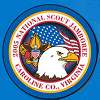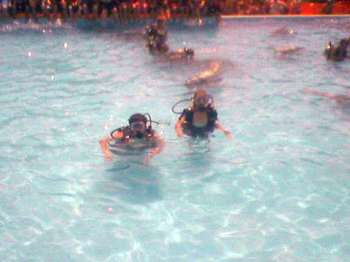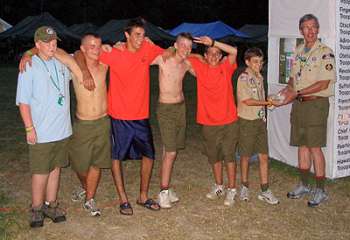- By -
- Around Town
 Print
Print  The 2005 National Boy Scout JamboreeThe drive was a long one, about 9 hours. The countryside was beautiful. But I had arrived, at Fort A.P. Hill, in Caroline County, Virginia. I had arrived at the place where the National Boy Scout Jamboree was being held. It was Friday July 22, 2005 and it was about 3 PM and it was HOT! I waited in line with a large group of Scouting volunteers who came to help make the Jamboree an event that would be long remembered.
The 2005 National Boy Scout JamboreeThe drive was a long one, about 9 hours. The countryside was beautiful. But I had arrived, at Fort A.P. Hill, in Caroline County, Virginia. I had arrived at the place where the National Boy Scout Jamboree was being held. It was Friday July 22, 2005 and it was about 3 PM and it was HOT! I waited in line with a large group of Scouting volunteers who came to help make the Jamboree an event that would be long remembered. I was assigned to the Health and Safety Division of National Headquarters. My official title was Assistant Chief Medical Officer to the North East Region Sub Camp Medical Clinics. I was to act as a liaison between the National Health and Safety Headquarters and the Medical Clinics in each of the five North East Region Sub Camps. There were twenty sub camps at the Jamboree. Within each Sub Camp there were anywhere from thirty to fifty troop campsites. I was to visit the North East Region Sub Camps each day morning and afternoon, and attend the Chief Medical officer meeting each day for updates of the chief medical problems of the day. The biggest problem, Saturday, Sunday and Monday was the heat. According to the Virginia residents I had a chance to speak with those days were the hottest on record for that area of Virginia. It was very unusual they said, to be that hot for that long. But the following two days would be even hotter.
The Jamboree troops began arriving on Sunday, and as each troop descended from their air conditioned bus into the Southern air, they were met with a "fire blast" of heat and sun. Immediately, the leaders and the medical staffs swung into action to urge the contingent members to drink lots of water, and to stay cool by wearing hats and light weight clothes. Equipment was moved off of trucks and busses and transported by the boys and their leaders to their respective campsites. A lot of hard work, a lot of sweat, and a lot of water. By Monday evening Fort A.P. Hill had become the fastest growing community in the United States. Forty five thousand plus residents were now in place were less then forty eight hours before there had only been about five thousand volunteers. The transformation was remarkable. Each sub camp now had rows of tents, portable pavilions, picnic tables, and gateways erected. Each of these gateways were specially prepared by each contingency to identify something special about the Troops that resided within that particular area. I witnessed gateways that resembled giant redwood trees, and the George Washington Bridge. The bore makings of conquistador shields, the SoBe refreshment drink mascot, Garfield and Odie and bowls of Jello. The creativity was evident everywhere you went. The boys and adults displayed and traded patches with likenesses of Yoda, Marvel Comic book characters, dinosaurs, all kinds of flags, eagles, Surf Boards, Submarines and Jet fighters. The colors and the images were fabulous.
The contingency from the Baden-Powell Council, which comprises the Tompkins, Cortland, Chenango, Owego, Broome Counties and a portion of Susquehanna County, Pennsylvania, arrived Monday morning the 25th, after leaving late Sunday evening July 24th. Among 72 boys and 8 adult leaders were six boys from Lansing, NY all members of Lansing Boy Scout Troop 48. They were, Joshua Barber, Michael Coles, Daniel Comisi, Ian Garnett, A. J. Hughes, and Peter Stammer. Their first task was to have their medical health forms reviewed and there overall health screened. Once this was done they were able to unload and transport their gear to their campsite, set up their tents, assemble tent pavilions and picnic tables and other needed patrol items before they could get their personal gear stowed away in their tents. Again, a lot of hard work, a lot of sweat, and a lot of water consumption. Finally after completing these tasks they were able to go and explore the Jamboree areas. They returned back to their campsites that evening and probably began to hear about the unfortunate events that happened in Sub Camp 7 where the adult leaders from the Western Alaska Council had been killed in a tragic accident.
This cast a pall upon all participants and staff members that evening and the following day. But it was important for the boys to try to get back to they were there to do. Have fun, fellowship and try things they might have never tried to do before. So both staff and adult leaders counseled the boys and helped them find ways to honor those men who had devoted their time to the Scouts of the Alaska Council, and plans were made for Thursday evening, at which time each Sub Camp would hold a memorial service for those fallen Scout leaders. With that in place the Jamboree moved forward.
From 9 AM to 5 PM each day (except on Arena days) the boys would have the chance to do various activities at Action Centers which offered activities such as rappelling, trap shooting, BMX bike rallies, and archery. Other activities were Outback Centers which included Fishing, Canoeing, Kayaking, Sailing, Snorkeling and what seemed to be a big favorite Scuba instruction. (I tried this and it was GREAT!). Additionally, the participants did other activities such as Ham radio operation and licensing, and disabilities awareness activities.

Troop 48's Peter Stammer (left) and Daniel Comisi (right), learning to use Scuba gear.
Lunches came from a Lunch Kiosk, which provided pre packaged lunch sandwiches, cold drinks, fruit, puddings and snacks each day at lunch. The participants would have to prepare and cook breakfast and dinners themselves, using Patrol boxes that contained pots, pans and other cooking items needed for the boys meals. Their food items for these meals were provided twice daily by the Sub Camp commissary. Each day, twice per day, they would have to draw water from the camp water sources, which were quite a distance from their campsites.
On Wednesday, the temperatures began to soar, reaching 104 at times. But it was also the day of the first Arena show, at which President Bush was to speak. All Activity/Outback and other Centers closed early so the boys could have an early meal, and then prepare to march to the Arena for the show.
The medical teams knew it was going to be a difficult afternoon and evening, and prepared to tackle the problem as best they could. Large water tanks were set up along the routes the boys would take and misting tents were prepared at the arena to help the participants and staff cool off in the soaring temperatures and humidity. The trek to the arena was long, and many of the participants had difficulty along the route. The various medical team members did their best to help these people. But once they arrived at the open air arena, the hot sun beat down on them and more individuals were overwhelmed by the heat. We (the medical team members, military members, etc.) carried many boys and adults up to the medical tents to help them rehydrate and recover from the heat. Luckily the arena show was canceled at 6:10 PM and the participants were able to get back to their campsites before a very significant thunder storm rolled through Fort A.P. Hill. The storm passed by 9:30 PM and things settled down in the camps. The medical clinics and hospitals however, were quite busy well into the night and the early morning.
Thursday, it cooled down. And we were all thankful for 80 degree temperatures. The arena show, which could have been held that evening, was cancelled. The boys were glad, they would now be able to enjoy all that the Jamboree had to offer, without having their activities curtailed early in the day.
On Friday morning the boys were able to participant in a 5K run/walk activity, and this was well attended, especially by our boys from Lansing. For some reason, some of the boys decided they wanted to cut their hair while at the Jamboree, and came up with an idea to raise some money for the World Friendship Fund, the fund that supports Scouting in underdeveloped countries around the world. So, as they proceeded to shave their heads, other scouters in Boy Scout Troops 306 and 307 collected funds from other Scouts. They raised $81, which they then brought to the Sub Camp 3 Chief.

Daniel Comisi (second from right) presenting monies collected for World Friendship Fund to Sub Camp Chief John Chambers, after two Troop mates shaved their heads.
Saturday afternoon, was a highlight day for the members of Troop 306 and 307, since that is when Dr. Steven Squyres, the scientific Principal Investigator for the Mars Exploration Rover Project, involved in exploring Mars with NASA's two Mars rovers, Opportunity and Spirit. arrived at Camp. He paid a special visit to the boys from the Baden-Powell Troops, since they were his "home" troops. He then proceeded to Sub Camp Headquarters for a special ceremony held in his honor. It was a very nice event.
On Saturday or Sunday each youth had the ability to attend the religious services of their choice as part of Scouting's mission of Duty to God for all Scouts and Scouters. From what I saw just about every denomination held a service, and at each area, the numbers were great. At the Catholic service, there were what seemed to be at least ten thousand people assembled. It was quite a thing to see and experience.
Sunday afternoon rolled around and we all prepared for the "Final" Arena Show, which was an interesting term to use, since there was no First or Opening Arena Show. The temperatures stayed reasonable, 85 degrees or so, and everyone was very optimistic about the show being a successful one. At 7:10 PM that evening, President Bush was introduced to a standing ovation. His speech was terrific. The audience, which was estimated to be at 75,000 people (Scout leaders, Scouts, and guest visitors to the Jamboree), was on their feet for most of the speech. Once he left the stage the audience relaxed and watched the show, waiting for the finale firework and laser display. As we watched the ongoing show, we heard a helicopter in the distance. Suddenly we saw it circle the Arena, it was Marine One, carrying the President. It flew around the Arena once and then sped away.
The wait for the Firework and laser show was eternal. It was highlighted by the convening of a National Court of Honor to recognize the extraordinary bravery of Scout Kendell Call, who at great risk to himself saved the life of his father during the tragic accident on Monday, July 25th and the introduction of the greatest living American Explorers, for whom which each of the Jamboree Sub Camps were named after. Finally, the Fireworks and laser show began, and it was phenomenal, and lasted at least 30 minutes.
The rest of the week was fairly uneventful, with all the boys trying to complete the various activities they wanted to finish in order to earn their activity "rockers" or finish up merit badge requirements before packing up and heading home on Wednesday morning.
Almost as soon as they had arrived, the Jamboree participants began preparing to go home. Gateways were deconstructed, pavilions, picnic tables and tents taken down. Tuesday night, the boys would sleep out under the stars with no coverings over them. It was a cool damp night, and most awoke with rather moist sleeping bags from the dew that had accumulated overnight. They then finished their packing of their gear, "lugged" it up to the loading area, and then loaded the truck. Once this was done, they climbed up into their buses, and left for home.
I'm pretty sure that no one that attended the 2005 National Boy Scout Jamboree will soon forget what they experienced, nor the people they met, or the men that died in the accident. It certainly will be something I will think on for years to come. Who knows, perhaps some of the boys from Troop 48 will consider returning to the 2010 National Boy Scout Jamboree as members of the Jamboree staff, and help celebrate 100 years of Boys Scouting in the USA.
----
v1i4
v1i4



